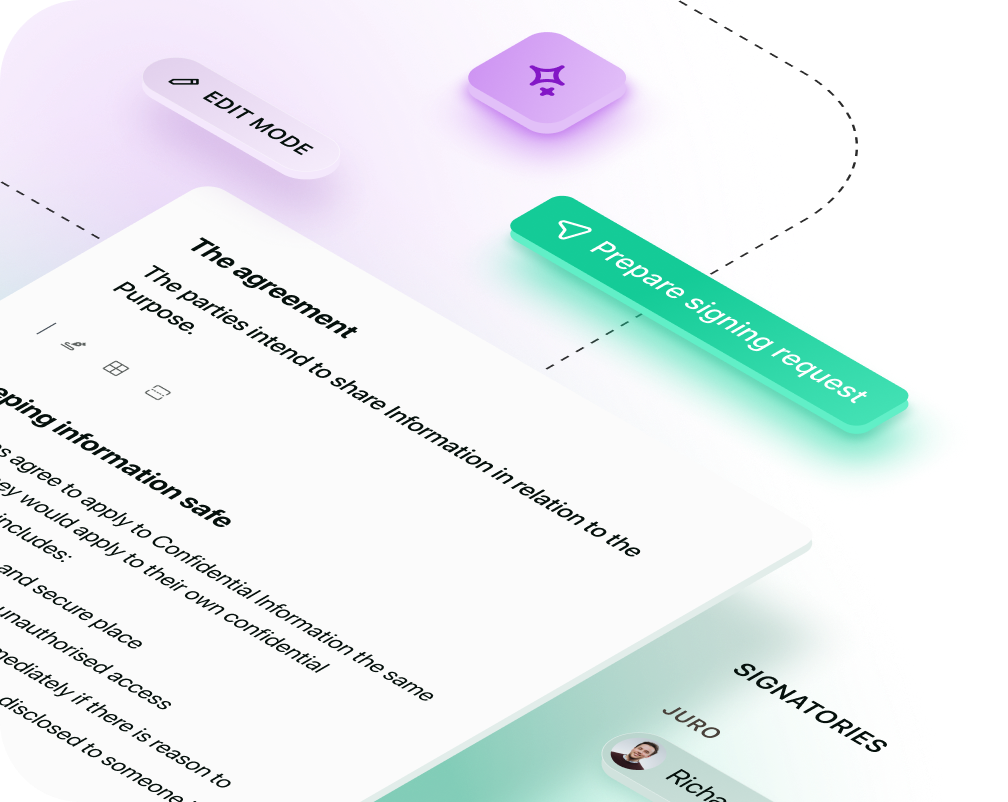Solutions
Customer Support
Resources
Looking for a music publishing agreement template? Download this free version today.




Managing music publishing agreements can be complex, but having a solid contract template can simplify the process.
In this article, we will explore everything you need to know about music publishing agreements. We will cover what they are, their purpose, who manages them, when they are used, and what should be included in a template. We’ll also look at the manual approach to managing these agreements and how Juro can automate the process for you.
A music publishing agreement is a legal contract between a music publisher and a songwriter or composer. This agreement outlines the terms under which the publisher will promote, exploit, and manage the rights to the songwriter's compositions. It is a crucial document that ensures both parties understand their rights and obligations regarding the use and earnings from the music.
Music publishing agreements cover various types of rights, including:
The primary purpose of a music publishing agreement is to define how the rights to a song or composition will be managed and monetized. Here are some key objectives:
Ensures that the songwriter retains ownership of their work while granting the publisher specific rights to manage and exploit the music.
Details how income generated from the music will be split between the songwriter and the publisher.
Outlines the publisher’s responsibilities in promoting the music and securing opportunities for its use.
Provides a clear framework for both parties, reducing the risk of disputes and misunderstandings.

Music publishing agreements are typically managed by music publishers. These publishers can range from large companies to independent entities. The key roles involved in managing these agreements include:
Music publishers acquire the rights to the music, promote it, and handle the licensing and royalty collection. Songwriters and composers create the music and enter into agreements with publishers to manage their works.
Lawyers and legal advisors ensure that the agreements are legally sound and protect the interests of the parties involved. Performance rights organizations (PROs) – like ASCAP, BMI and PRS for Music –collect and distribute performance royalties on behalf of the songwriters and publishers.
Music publishing agreements are used in various scenarios, including:
A comprehensive music publishing agreement template should cover the following key elements:
Parties involved. Names and contact information of the songwriter and the publisher.
Grant of rights.: Details of the rights being granted to the publisher, including mechanical, performance, synchronization and print rights.
Term and territory. Duration of the agreement and the geographical area covered.
Compensation. How royalties and other income will be split between the songwriter and the publisher.
Publisher obligations. Responsibilities of the publisher in promoting and managing the music.
Songwriter obligations. Responsibilities of the songwriter, such as providing compositions and cooperating with the publisher.
Audit rights. The songwriter's right to audit the publisher's records to ensure accurate royalty payments.
Termination. Conditions under which the agreement can be terminated.
Dispute resolution. Methods for resolving any disputes that may arise.
Creating and managing contracts involves several crucial steps. By following these steps, organizations can make sure all parties understand their obligations and that agreements are clear, compliant and serve their intended purpose throughout the contract lifecycle.
Here’s a detailed breakdown of the process:
Before drafting, gather all necessary information and understand the requirements of both parties. This includes:
Using the information gathered, draft the contract. Make sure it is clear, concise and legally sound. Key sections typically include:
Before sharing with the other party, conduct an internal review to ensure the contract aligns with company policies and legal standards. Involve relevant stakeholders such as legal, finance and management teams.
Share the draft with the other party and enter the negotiation phase. Key activities include:
Once agreed upon, both parties sign the contract. This can be done traditionally with wet ink signatures or electronically using eSignature solutions.
Distribute copies of the signed contract to all involved parties and store them securely in a central repository for easy access and reference.

Actively monitor the contract to ensure all parties adhere to their obligations. This involves:
Contracts may need to be amended or renegotiated due to changing circumstances or new requirements. This involves:
As the contract term nears its end, decide whether to renew or renegotiate the agreement. This involves:
If the contract is not renewed, ensure a smooth termination process. This means:
Provide regular reports to stakeholders detailing contract performance, compliance and financials. This ensures transparency and accountability.
Conduct a post-contract analysis to learn from the process. Evaluate what worked well, what didn’t, and how future contracts can be improved.
Archive the contract and all related documents securely. This ensures that records are preserved for future reference, audits and legal compliance.
Juro’s AI-native contract management platform can significantly streamline the process of managing music publishing agreements for businesses. Here’s how Juro can help:


Juro’s AI-native contract automation platform empowers all teams to create, agree, execute and manage contracts up to 10x faster than traditional tools. To find out more, hit the button below to book your personalized demo.
Juro is the #1-rated contract platform globally for speed of implementation.


Juro embeds contracting in the tools business teams use every day, so they can agree and manage contracts end-to-end - while legal stays in control.
Book your demo